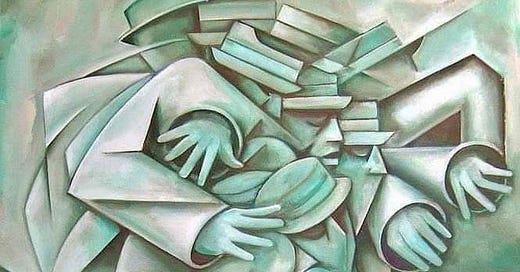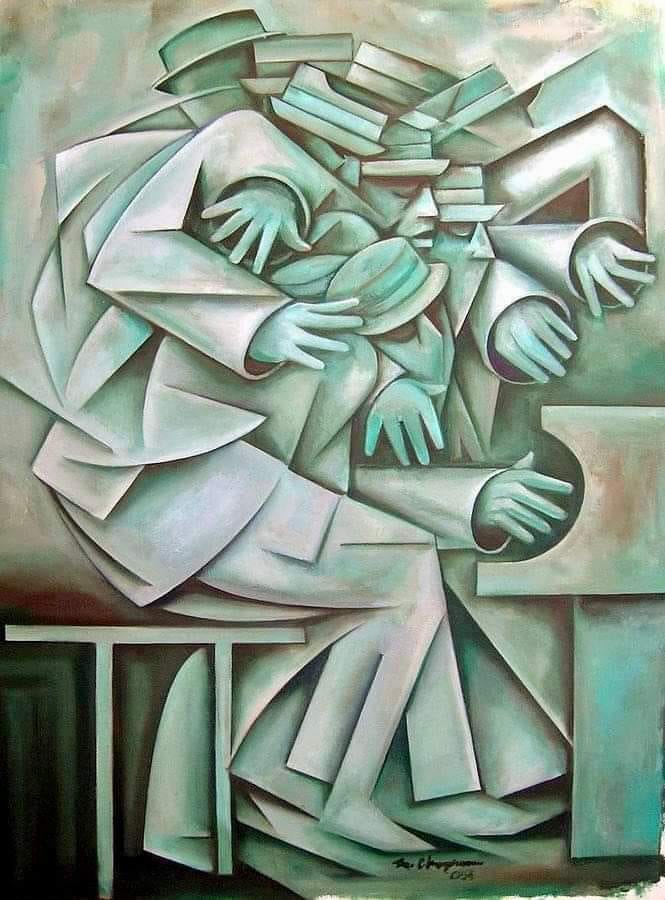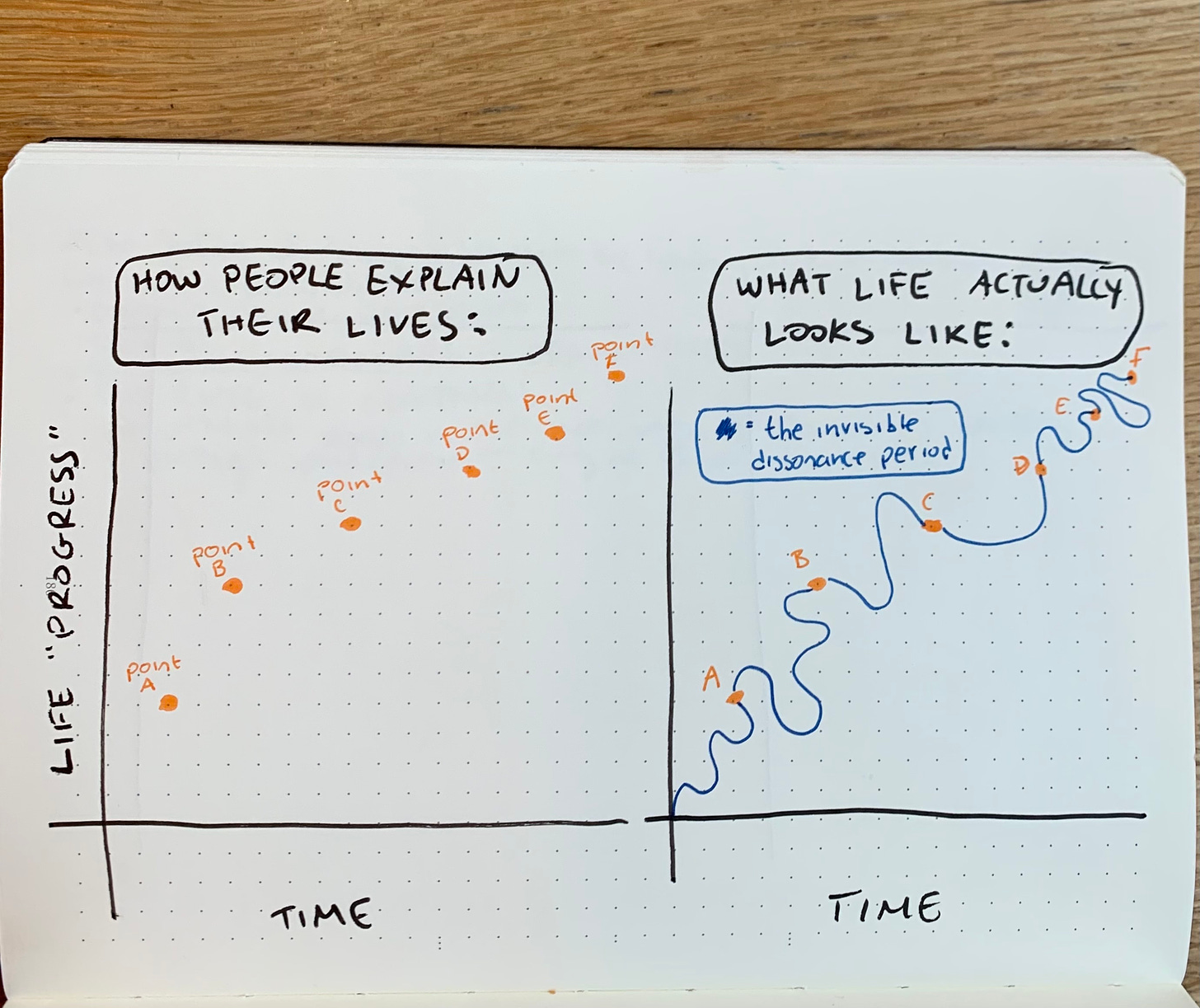I keep writing and then re-writing this essay—each time with a different title, its words pivoting around a new centrepiece, a novel way of approaching a feeling that has been running through my psyche for weeks now. After many fruitless attempts, I think I’ve finally arrived at a word that captures the emotions I’ve been trying to express: dissonance.
the feeling of being in between
You know that feeling of being in between two phases? That feeling of simultaneously moving away from something that no longer fits while moving towards something you almost fit into—getting out of a relationship or starting a new one, leaving/starting a job, moving to a new city, entering a new phase of life. This process of becoming—it’s not instantaneous. As much as we would like to, we do not go directly from one thing to the next. We get there by walking along this tight rope of dissonance. This process of shedding what you are coming out of while fortifying yourself with components of the phase you are coming into.
This in between phase is defined by its vulnerability: we feel raw, floating from one thing to the next—untethered, feet off the ground. It’s an uneasy, somewhat volatile state to be in. Like being a valence electron on the outer ring of an atom, the force keeping you fastened to where you are is weak, unconvincing, leaving you ready to depart when a ripe opportunity arrives. But you’re still there—in that in between phase—waiting for a clean exit, leaping only when you know you’ll land where you want to.
context
To make this more tangible: a few months ago I quit my job to pursue writing, but have maintained essentially the same life circumstances I was occupying before this decision. I’m living in the same house, with the same roommates, wandering around the same city. Naturally, busting through this one-way mental door, fixating my eyes on a new path, a new aim, caused some dissonance to begin brewing internally. Zeroing in on this new aim took my eyes off of the things I was previously focused on: things which largely revolved around the conventional path I was on that gave me a similar schedule, lifestyle, and set of priorities to those around me. This had all changed now—it wasn’t just my work that had shifted with my decision, but my entire mindset. I began feeling like a stranger wandering through context that used to fit but had suddenly become uncomfortable, restrictive. Like when your toes begin to press up against the edges of a pair of shoes you’ve outgrown. You’re ready for a new pair, but are hanging onto the ones you’re used to until you find the right pair to replace them with.

new software, same hardware
Undergoing this psychological change was like having my mental software wiped and replaced. I had re-programmed myself towards a completely new set of priorities. But the hardware—my environment—had stayed the same. Anyone who has held onto an iPhone for more than a couple years knows that once you start downloading new software onto an older device, it starts to glitch. Things that used to feel easy, natural, mindless begin to feel strange, frictional, unusual… like they no longer work properly.
When I made the decision to leave my job, every day suddenly became high stakes, a day of my personal runway, a day where I have to perform or face the consequences. The unglamorous reality of this is that everything else in my life became somewhat trivial in comparison. I’m not sure if this is the right way to go about things. In fact, I am pretty sure it is the wrong way to go about things in the long-term (the quality of your life is a function of the quality of your relationships and all that). But making the decision to do something on your own, with yourself as your maestro, means you need to go through a period of being heads down, not thinking about or focusing on anyone else. It means revolving your life around your muse. It means a phase of intensity.
Put simply: being in my old life while on my way to my new one has produced this unrelenting sense of dissonance—this feeling that I am performing, while I’m becoming. Neither here, not there. New software, same hardware. One foot in, one foot out, straddling two distinct phases of my life at once.
life is not discrete, it’s continuous
Through writing and re-writing this essay, I came to realize that, actually, this is quite a normal experience. When I started writing, I thought: I’m going to solve this! I’m going to find a way to leap past the dissonance! Snap myself from one phase to the other and tell you how to do it, too! But I’ve realized that dissonance is not only normal, but a necessary component of going from one thing to the next. Changes brew before they erupt—we’re just rarely told about that brewing period. When people (especially successful people) tell us about their lives, we hear about discrete points on their journey: I was A, then I became B, which helped me become C, and then I did D, which lead me to E, which I used to get to F.
We hear about people’s lives as though they are discrete, when really they’re continuous:
Not only is life continuous, it’s also not linear. The blue path doesn’t look like it’s going to reach the next orange dot until suddenly it does, right before it arrives there. The path it follows is nearly impossible to predict or model accurately, because it’s chaos. But the chaos is part of the order—it’s just hard to see this in the moment.
There’s a Steve Jobs quote that always rings through my mind whenever I feel like I’m lost, or halfway between things, or not sure where I’m going to end up:
“You can't connect the dots looking forward; you can only connect them looking backwards. So you have to trust that the dots will somehow connect in your future.”
I used to think that dissonance, being “in between” things, was something to be solved, avoided, rushed through, but I now see it as something we all experience and rarely discuss—a necessary part of evolving. We’re all on our way from one data point in our story to the next, walking along (an often chaotic and unpredictable) swerving blue line of dissonance. The dissonance piece is just as critical as the next well-punctuated point in our one-day story where the dots will all somehow connect.
So, while I thought I was going to end this essay by explaining how to zoom past dissonance, I’ve instead arrived at a formula I have been finding great comfort in:
forward momentum + patience = solution to dissonance
The one hedge, or solution, to dissonance I’ve found is to just put my head down and keep doing what is getting me closer to who I’m trying to become. Put in the work, focus on the aim, honour the priorities. Don’t get distracted by the fact that you’re not there yet. As long as there is forward momentum building in the desired direction, you are getting there.
While some changes involve radical and instantaneous transformations, most changes rely on momentum building towards that next orange dot. We rarely reflect on the slow, brooding process of change, though. Once we get to the next thing, we’re focused on the next thing, not on the journey we just went on to get to where we are. We seldom hear about this part of the journey from others either, which is why we feel so alone in experiencing it. Instead, we hear their over-simplified summary—point A to point B, as if there’s a time vacuum between the two. But beneath these pronounced changes are pathways of dissonance connecting one phase to the next.
We’re all just walking contradictions intrinsically: physically here, mentally elsewhere, wanting to be something that we aren’t yet. This is the human condition. Especially if you’re ambitious. We’re always aiming at something new, trying to become more than we are. And there’s some comfort in that, I think—to know we’re always transitioning from one thing to another. Performing, becoming, introspecting, all at once.
We all collapse our internal complexity to operate in the world as a cohesive creature—as we should! We can barely handle our own dissonance, let alone digest everyone else’s. There is no way for our environment to interpret and juggle all of the half-baked internal beliefs and versions of ourselves we are simultaneously developing and unraveling. Dissonance is personal, it’s not something your environment can or should solve for you. It’s something that, with patience and progression, will dissipate over time as you arrive at your next phase—the next “dot” in your life. And since we can only connect the dots looking back, we can take comfort in the fact that we will eventually get to the end of any dissonance period, shedding the vestigial mental pathways of our old software when we do.
dissonance is mental impermanence, materialized
Becoming is an impermanent process. We are shedding, gaining, evolving, all at once. To be in that liminal space between two phases is to wander along a non-linear path lined with dissonance. It is disorienting to be on that blue rollercoaster going from one dot to the next, but at least you’re on it in parallel to everyone else, who also have no clue how their dots are going to connect, you know? We’re all following these winding, invisible paths of dissonance—travelling from our old self to our future self, as our present self. If that sounds confusing, let us recall what Jobs points out so wisely: it only makes sense in hindsight.
So if it feels like you’re outgrowing your past self but aren’t sure where you’re headed, it doesn’t mean you’re glitching—it probably just means you’re human. No matter how hard we try to push that ball of momentum forward, we can’t change that life requires as much patience as it does focus—that it is a continuum where we are constantly evolving, not a scatter plot of discrete versions of ourselves.
There’s an element of change that requires surrender. We can’t move forward while rejecting our mental impermanence. So, instead of resisting, resenting, or trying to rush the process of becoming, we might as well just buckle up and enjoy the ride. Because whether we make peace with the dissonance along the way or not, it’s the only path that can take us from Point A to Point B.
PS — If you enjoyed this, say hi on Twitter. You might also like a piece I wrote about personal ambition.






I love your equation of patience + forward momentum. The way I think about this problem is the difference between focusing on your displacement and focusing on your direction. At point A, rather than worrying about how far you are from B, just point yourself in the right direction and take the next step.
Thank you for a thought-provoking piece, Isabel!
Reminds me of this web comic: https://www.instagram.com/p/CbN9NBZpyAf/
The idea that the ego dissolves when we make changes that break us out of our identity, and you might feel a little confused and lost at first. I recently started admitting to coworkers that I struggle with ADHD and it was hugely discombobulating and disorienting. 😱 I can see how it'd add another layer of dissonance to make a major change in one area, but the rest of your environment looks/seems the same.